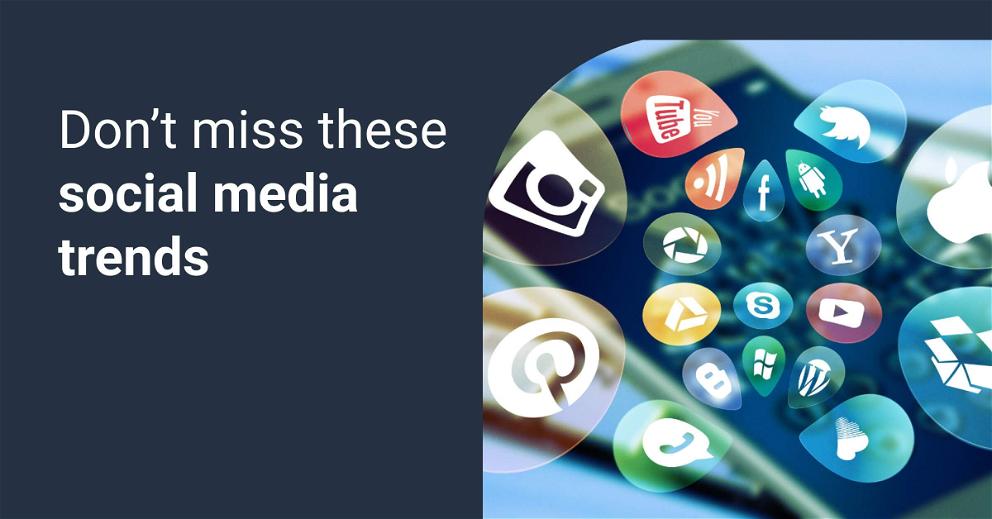4 Key Social Media Trends To Follow in 2025
Social media trends and everything you need to know to hop on them. From augmented reality to online events. Read to find out more!

Jun 16 2021 ● 7 min read

As 2020, events forced people to remain physically distant, social media bridged the gap and kept users connected. According to Datereportal, nearly half of the respondents are using social media daily due to COVID-19. And as the significance of social media platforms is growing, people are adopting new trends and behaviors faster than ever before.
Over 4.7 billion people are connected to at least one social media, and businesses are not only searching for new ways to stay in touch with their audience during the pandemic. Instead, they question themselves, “what will be the next trend and how do we stay relevant?”.
1. Social shopping
43% of global shoppers research products online via social networks. Social media platforms giants like Facebook, Instagram, Pinterest and others started to roll out social commerce tools making it easier for brands and customers to get connected. Businesses can now build their e-commerce presence on media platforms alone and fit the changing shopper’s behavior.
Facebook and Instagram are the most popular social shopping channels. 70% of consumers are looking at Instagram for product discovery. 36% of the Facebook users already shopped through the Facebook platform and are planning to do so in the future. Back in 2020, Facebook introduced Shops, where users can browse brand products in the app. Instagram rolled out a pack of social commerce tools, such as Shoppable posts, allowing users to see the tagged products in the post. In addition, Instagram marked all posts featuring products with a special icon and introduced a dedicated “Shop” tab.
Setting up social media stores and making posts shoppable are the top social media management best practices for coming years since in-store shopping is still risky. If brands don’t adapt their business strategy to fit changing consumer behavior, they can lose the battle for relevancy.
2. Ephemeral content
It’s the type of content that vanishes after 24 hours. Facebook, Instagram and Snapchat Stories are perfect examples of this type of content. Today, consumer’s attention spans are extremely short and limited. Through the years, social media users have developed a way to consume overwhelming content - quick and straightforward. And stories are one of the most addictive features in social media, as the user can browse through masses of content in minutes.
Ephemeral content plays on the concept of FOMO (i.e., the fear of missing out), and that’s why it’s so popular. It creates an urge to watch it before it’s gone. As a result, stories’ popularity continues to rise: Instagram stories alone grew from 150 million in 2017 to 500 million in 2020 and are projected to reach 750 million daily users this year. That’s a lot of potential customers!
3. Augmented reality in social media
AR is the virtual element brought into the real world, providing an immersive experience to the user. Augmented reality is one of the most emerging technologies nowadays, and as more consumers are interested in it, integrations of AR are starting to pop up in social media.
Filters, mini-games, animated backgrounds - businesses can create all sorts of AR branded content. For instance, 43.7 million social media users used the AR filter at least once a month in 2020 compared to 38.2 million in 2019.
A great example of hopping into an augmented reality trend is makeup company L'oreal Paris. Once Instagram and Snapchat released their SDK for creators to develop their filters, the company made a series of signature looks featuring their makeup products. Shortly after the filters debut, the company’s sales drove a gain of 1.6% of comparable sales reversing the 19% fall in the prior quarter.
4. Going live in 3, 2, 1!
As all live events were restricted due to the pandemic, brands moved them online through live streams. Instead of investing in expensive event-hosting software, many businesses moved their events entirely to social media platforms like Facebook, Instagram or Youtube. Since social media isn’t bound to one location, live streams can be a handy tool to reach out to global audiences and your brand’s loyal customers.
GlobalWebIndex data on consumer trends in 2021 shows that 29% of internet users across seven countries frequently watch live streams from influencers and companies they follow. Among those users, 80% say they’re likely to buy a product after the live stream.
Bottom line
While 2020 was a dark time, it brought a lot of innovations into the social media landscape. And as social media continues to weave itself into our daily lives, its usage will continue to rise.
In the socially distanced routine, social media is the place where people can get connected. And that is what all of the new trends are about - staying connected with family, friends and brands people love.
Published on Jun 16 2021

WRITTEN BY
Benediktas KazlauskasBenediktas is a detail-oriented writer with a passion for marketing and technology. Using his vast experience in Business Management and Sales, he approaches every blog with the same idea: How to make readers come back for more?